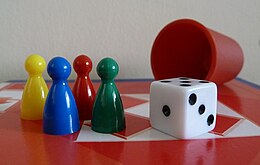Ludo (game)

|
|
| Years active | Since c. 1896 |
|---|---|
| Genre(s) |
Board game Race game |
| Players | 2–4 |
| Age range | 4 and up |
| Playing time | < 120 min |
| Random chance | Medium (dice rolling) |
| Skill(s) required | Strategy, tactics, counting, probability |
Ludo /ˈluːdoʊ/, /ˈljuː-/ (from Latin ludo, "I play") is a board game for two to four players, in which the players race their four tokens from start to finish according to die rolls. Like other cross and circle games, Ludo is derived from the Indian game Pachisi, but simpler. The game and its variants are popular in many countries and under various names.
Pachisi originated in India by the 6th century. The earliest evidence of this game in India is the depiction of boards on the caves of Ajanta. This game was played by the Mughal emperors of India; a notable example is Akbar. The Royal Navy took Ludo and converted it into the much loved messdeck game of Uckers the rules of which can be found on any RN website.
In England, Pachisi was modified using six-sided dice and patented as Ludo in 1896, patent number 14636.
Special areas of the Ludo board are typically coloured bright yellow, green, red, and blue. Each player is assigned a colour and has four tokens of matching colour. The board is normally square with a cross-shaped game track, with each arm of the cross consisting of three columns of squares—usually six squares per column. The middle columns usually have five squares coloured; these represent a player's home column. A sixth coloured square not on the home column is a player's starting square. At the centre of the board is a large finishing square, often composed of coloured triangles atop the players' home columns (thus depicting "arrows" pointing to the finish).
...
Wikipedia
